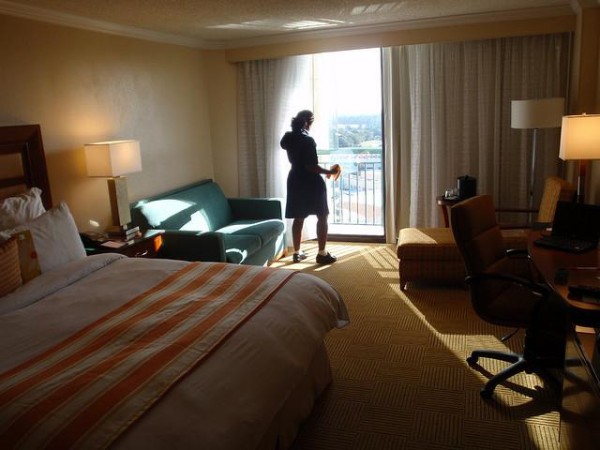Tipping: Who Gets Too Much; Who Gets Too Little?
I think I’ve finally got the business of tipping in restaurants pretty well sorted out. I tend to tip around 20 percent in the more ordinary establishments where the modest prices mean smaller gratuities, but closer to 15 percent in the “fine dining” establishments where the higher menu prices mean bigger tips. (I never stiff a server, even if they’re lazy and unpleasant; they’ll just think I’m a cheapskate. Instead, I’ll leave two bucks; that sends the right message.)
I must say, I like the French approach, with the tip automatically included in the overall tab. Yes, there’s the potential of the mandatory gratuity going to an undeserving server, but that’s a respected profession in France and I’ve found the service there to be almost universally excellent.

On the other hand, appropriate tips for housekeeping staff in hotels has caused me angst for years. Typically, I would be looking over the room one last time before checking out when I would suddenly think about leaving something for the housekeeping lady. I’d pull out my wallet and … Damn! Two or three fifties and one single, meaning I would slink away leaving the dollar bill and 23 cents (all my pocket change, mostly pennies).
Then about a dozen years ago, I had a kind of epiphany … a realization that a hotel housekeeper—whether at a Best Western in downtown Seattle or the Fairmont’s Chateau Frontenac in Quebec—was performing the most menial of tasks, directly affecting my comfort, no doubt for minimum wage or close to it.
Furthermore, it also dawned on me that it was a mistake to leave a gratuity for the entire stay as I was checking out, not knowing if the lady cleaning the room that day was the some person who had been making my bed and mopping my bathroom floor during the previous three days. Ever since that belated moment of illumination, I make a point of leaving four or five dollars on the pillow every morning during my stay when I leave my room.
For Amtrak travel, I tip my sleeping car attendant a minimum of $5.00 a night for average service—double that if my wife is traveling with me—and double that again if the attendant is genuinely pleasant and I’ve asked for any extra service. Tips for servers in Amtrak dining cars should be at least 15 percent of the published menu prices. It’s very disappointing, but some sleeping car passengers don’t tip in the dining car because their meals are “free”, with the cost included in their fare. When you stop and think about it, that makes no sense at all. Adding insult to injury, the IRS assumes they are being tipped and they’re taxed accordingly.
Bottom line: tipping is part of the system, like it or not. (And, yes, of course we should increase the minimum wage!)




Meals are also included in First Class on VIA’s “The Canadian;” yet, I found myself on my last trip in January, 2014, tipping $100 the last night just for my diner crew from Vancouver-Winnipeg. Why? Because the Service Manager (Steward) ran a perfectly immaculate food & beverage operation between the diner and Park car bar–clean; meals cooked to order; cocktails perfectly made; always offering a spirit at every meal; no slouching or anger expressed by the crew–just warmth and smiles; a true graciousness for the tip. Indeed, when I do my next trip up there, it will be a turn at Winnipeg back to Vancouver with that crew!
Amtrak is hit or miss; taking their lead from the diner’s LSA (Steward). If I have identified a competent and pleasant server, I will keep to their table for the trip, tipping 20% per meal. Unfortunately, too many times I have not been inclined to leave even $1 on the table, given the indifferent attitude; however, I have made it a point to explain to the LSA in charge my feelings–and suggested corrective action.
Same goes for the sleepers-I had one super attendant in all my years, (from the Seattle base of course)–she changed light bulbs ignored by the yard; grabbed beers and ice before the bar was officially open-just terrific. So, she earned a $25 tip for the one night, 28 hour trip from Chicago-Whitefish, MT. Going east by train, you have to inquire will somebody handle the luggage; forget about the attendant going to the bar 4-6 cars forward to grab drinks; yet, they are first off at the end point saying good-bye with arm outstretched.
In USA, taxis receive approximately a 15% tip, backing out all extra charges, tolls, and taxes–if they “don’t drive like they’re stealing the car!”
Amtrak employee like all employees make good money with terrific benefits (like all government employees and why Amtrak loses money). Not saying you shouldn’t tip, just don’t feel too sorry for them.
Glad to read your comment, Drew.
Yes in both NZ and Australia, I hardly ever tip. I round up a taxi fare to the next dollar and have been known to give $2 to a very pleasant waiter. They get better wages per hour than I did as a school teacher. I do not tip in Europe either. It is a nightmare that discourages me from visiting the USA and the idea of adding taxes afterwards means you end up with all those horrible small coins. I now try to stay in private apartments (airbnb)ifstsying more thsn 2 nights and buy my own food in supermarkets or go to fast food sites. I am afraid I have never left a tip for the housemaid except in India in 1974 when the amount was chicken feed.
Brian (An Australian living in wonderful NZ)
Yes! Why can’t we get rid of the annoying pennies and nickels in the USA like they have in New Zealand! Makes no sense at all. I love how taxes are included in all prices so you know exactly what everything costs. You are lucky to live in such a beautiful place!
I just returned from a wonderful trip to New Zealand. There they pay their servers a decent living wage and tipping is not expected. As a matter of fact it is impossible to add a tip to your check if you are paying electronically. The only exception to this we learned was in the high tourist areas along the Auckland waterfront. I guess you could say that the tip is included in the price of the meal as stated on the menu – not a add on at the end. The same goes for taxes. I liked that as you know exactly what you are paying when your order your meal – the price on the menu. No add ons when you get the bill.